Lochinvar announces the launch of its XCalibur™ Condensing High Efficiency Tankless Water Heaters with X3® Scale Prevention Technology. Bringing to market new premium features, including an integrated recirculation pump and patented heat exchanger; enhanced installation flexibility and high efficiency performance, the XCalibur tankless water heater supports busy contractors and homeowners. Available in 160,000-; 180,000-, and Read more
HVAC
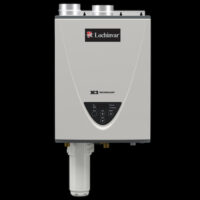
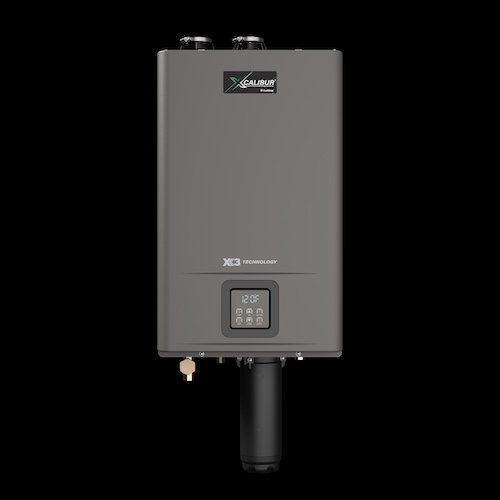 Lochinvar announces the launch of its XCalibur™ Condensing High Efficiency Tankless Water Heaters with X3® Scale Prevention Technology. Bringing to market new premium features, including an integrated recirculation pump and patented heat exchanger; enhanced installation flexibility and high efficiency performance, the XCalibur tankless water heater supports busy contractors and homeowners.
Lochinvar announces the launch of its XCalibur™ Condensing High Efficiency Tankless Water Heaters with X3® Scale Prevention Technology. Bringing to market new premium features, including an integrated recirculation pump and patented heat exchanger; enhanced installation flexibility and high efficiency performance, the XCalibur tankless water heater supports busy contractors and homeowners.
Available in 160,000-; 180,000-, and 199,000-BTU/hr units and a Uniform Energy Factor (UEF) of 0.95, the XCalibur line of premium tankless water heaters fits a variety of installation needs. Patented X3 Scale Prevention Technology comes standard on three XCalibur models. Other models are available with X3 Technology as an optional accessory. X3 Scale Prevention Technology inhibits scale build-up and corrosion to extend the life of the unit up to three times longer. The XCalibur tankless water heater requires zero lifetime descaling maintenance, meeting the needs of busy contractors and homeowners. XCalibur units also qualify for state and local rebates and are ENERGY STAR®certified.
“With every product we offer, Lochinvar advances the technology and features available to contractors to improve their day-to-day life, and the XCalibur does just that,” said Lochinvar Senior Product Manager Rhea-Anne Pendley. “Thanks to its installation flexibility and X3 Scale Prevention Technology, contractors can now directly address a homeowner’s needs. Contractors no longer have to return to their wholesaler for a different unit or return to a jobsite for scale maintenance—saving time and money.”
To enhance installation flexibility, the XCalibur line offers two- and three-inch dual pipe direct venting, ½- and ¾-inch gas line options and universal indoor/outdoor installation. The unit is designed so it can be converted from natural gas to liquid propane in the field with the included kit. All of these features work together to provide plumbing professionals with exceptional installation flexibility when working in the field. Plumbers now have a unit that conforms on the spot to fit their needs, regardless of install location, fuel type or existing venting.
XCalibur tankless water heaters also include several high-end features frequently requested by homeowners, including Wi-Fi capability for remote monitoring and peace of mind and an integrated recirculation pump that provides instant hot water and eliminates the time homeowners typically spend waiting at their fixture for water to heat up.
To learn more about Lochinvar’s XCalibur Condensing High Efficiency Tankless Water Heater with X3 Scale Prevention Technology, visit www.Lochinvar.com or XCalibur™ Condensing High Efficiency Tankless Water Heaters with X3® Scale Prevention Technology.
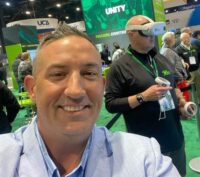
Virtual and simulation training isn’t necessarily new to the industry but its acceptance has been met with intrigue, and trepidation. But to say that this is the future of training? Not so fast. The consensus thoughts regarding this type of training is that will never replace in-person or on-the-job training, but it will become a Read more
Virtual and simulation training isn’t necessarily new to the industry but its acceptance has been met with intrigue, and trepidation. But to say that this is the future of training? Not so fast. The consensus thoughts regarding this type of training is that will never replace in-person or on-the-job training, but it will become a cog in the overall “wheel” for training assets.
According to Taco Comfort Solutions’ Product & Application Instructor-East, Dave Holdorf, Taco doesn’t want to change its training necessarily, rather seek to enhance the training experience.
“We ask many attendees how we can improve our classes and seminars. One of the most frequent replies is: ‘Add a hands-on section to the class; the theory is great and useful, but I want to install.’
“In a classroom setting, this can sometimes be difficult for the space needed, the time it takes, and to accommodate the different skillsets of attendees. We believe we’re now on a track with virtual reality (VR) training to give that experience to attendees—whether they’re seasoned pros, or new to the trade. VR can help to guide participants in what to look for, and more importantly what not to do on a project,” says Holdorf.
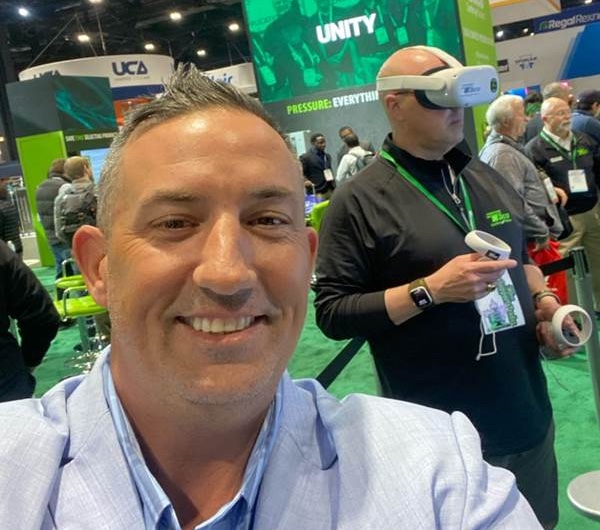
F.W. Webb’s Michael DelConte checks out the VR display at the Taco booth during the AHR Expo.
Ken Midgett, former teacher and apprenticeship Instructor, Lehigh Career & Technical Institute, now Plumbing, Marketing Director with Interplay—whose mission statement is “Better Careers Better Lives”—believes that they can play a part in a person’s career trajectory with that person using Interplay’s content. “When a person engages in learning and increases both their fundamental knowledge and the steps to do a task, we are helping that person upskill and creating more career opportunities for them. The value of a product that interplay offers is the demand function. You do not have to wait until a class is offered you can just connect and learn,” says Midgett.
Adaptation to simulation and on-demand training is paramount to success for the learner and the business. Midgett says that traditional classroom learning for skilled trades is becoming more and more challenging for several reasons:
- Finding good instructors: Many think that because they know a skill, they can teach it effectively. As a former educator, this is not always the case. This leads to poor instruction and marginal learners who are not engaged.
- The cost: The cost of running and maintaining a hands-on training center is much higher than instructor salaries and consumables.
- Change or die: Young learners are not inept at learning from lectures. Most skilled trade learners need to be engaged with learning and it must represent meaningful learning.
- The disruption of classroom learning to the workday: A rationale for going to class in the evening for 2-3 hours is losing traction to young learners. Business owners become frustrated with learning times and days as they view this as unproductive time. Young learners need to be met where they are with training that fits their lifestyle.
Interplay Learning training, combined with the new employee with the right attitude who is coachable and willing to learn, can be an explosive combination with a win-win result. “Taking an apprentice and having them spend time training and learning with on-demand training and then pushing that person into the field with a skilled person to watch and do in the real world is the best way to train this person or persons at scale,” says Midgett, who says there are numerous other advantages to this model:
- On-job efficiency increases as the apprentice now possesses the foundational knowledge and skills to perform a given task.
• Relationships are better between the journeymen and the apprentice, as the journeyman perceives the apprentice as engaged and productive.
• Business owners experience low turnover, better culture, and increased revenue as these new hires have direction and are leaning at scale.
• Technicians feel confident in their work due to training and upskilling.
• Callbacks are reduced and remediation training for the technician to increase their confidence
• Service managers can focus on coaching and maintaining technician stats instead of being the only technical lifeline for numerous techs.
• When sending these apprentices to “factory training,” they can engage and understand this much better due to the foundational knowledge.
Nonetheless, Midgett says there are a few things to note and understand about simulation and on-demand training:
• On-the-job or hands-on training with higher skilled supervision cannot be replaced.
- Simulations are great at teaching steps and muscle memory of a task.
- Simulation or any on-demand training cannot teach “feel.” As an example, simulation training cannot teach the skill of what “tight” feels like with a pair of wrenches on threaded steel piping or how tight to make a tank-to-bowl connection on a closet, or how tight a screw should be on the control board. This is what the onsite skilled person or journeyman must understand and teach effectively on site.
“While VR, AR and simulation-based technology are great resources, I do not think that any one particular learning system or style is the future,” says Rich Camacho, CEO & Co-Founder, BlueRecruit. Having said that, Camacho utilizes Interplay’s services (all of Interplay’s certifications and courses live on BlueRecruit, and when a person completes an Interplay course, they can then add that qualification to their BlueRecruit profile to strengthen their profile for Employer) and he thinks Interplay is a fantastic tool to augment in-class learning and a great launch point for someone either just entering the trades or seeking to upskill a particular technique.
“However, at the end of the day true craft mastery will occur in the field with a wrench. As technology continues to improve and costs continue to decline, Interplay will play a larger and larger part of building the next generation of skilled trades professionals and we’re excited to work alongside them in building “Better Careers and Better Lives,” says Camacho.

If last month’s attendance during the IBS/KBIS Show in Vegas is any sort of indicator for anything, in-person trade shows are still thriving. We’re hearing that this was the most attended show of the past 15 years. According to the National Association of Home Builders (NAHB), more than 76,000 builders, remodelers, developers and other home Read more

Running into friends while enjoying the Vegas nightlife.
If last month’s attendance during the IBS/KBIS Show in Vegas is any sort of indicator for anything, in-person trade shows are still thriving. We’re hearing that this was the most attended show of the past 15 years. According to the National Association of Home Builders (NAHB), more than 76,000 builders, remodelers, developers and other home building professionals filled the halls, “the highest level since 2009, which reflects the bullish outlook of the residential construction industry.”
This year also marked the 11th anniversary of Design & Construction Week® (DCW), the co-location of IBS and the National Kitchen & Bath Association’s (NKBA’s) Kitchen & Bath Industry Show (KBIS). DCW drew over 117,000 attendees, and more than 2,400 exhibitors occupied over one million net square feet of indoor and outdoor exhibits.

Pfister Faucet’s Spencer Brown, the Hub’s John Mesenbrink, Tim Goff, Pfister Faucets, and Dominic Sims, ICC, talk about the importance, and popularity, of the American Plumber Stories series.
Anyone who has visited the Las Vegas convention center knows that there are basically four separate halls—North, Central, South and West. I am of the opinion that the Central Hall usually gets the influx of traffic initially—over the course of the three-day event—with crossover to the North Hall fairly fluid. The North Hall is generally reserved for big bathroom players, and Central and South are filled with construction/builder booths. The West Hall, honestly, is almost at a different location where, in order to get there most of the time, you are sent underground, blindfolded and whisked through a tunnel via a manned Tesla. Pretty cool experience, actually, but not necessarily ideal if you are exhibiting in West because that’s where the trickle or “if I have enough time” traffic goes. My opinion, of course.
Oh, I almost forgot. There are a number of exhibitors set up outside—our friends from the Propane Education & Research Council (PERC), for example—right in front of Central Hall. The blue sky, 70° temps didn’t hurt those outdoor experiences either.
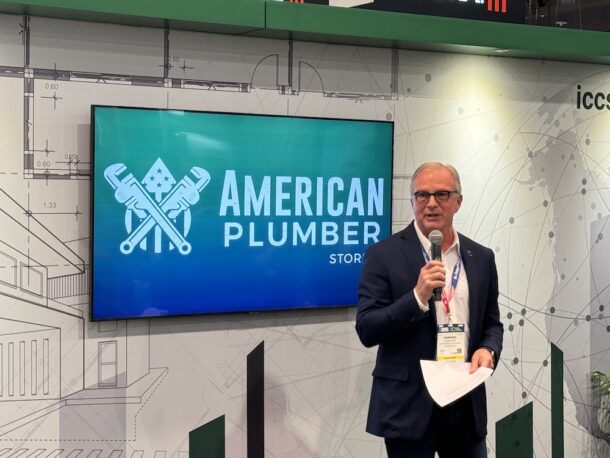
Dominic Sims CEO, International Code Council (ICC), talks about the partnership with American Plumber Stories for upcoming season 5 of the wildly popular docuseries.
Just a note of interest here, getting the show is getting easier with access to the monorail, which makes stops to a number of hotel locations—if it looks full, just keep nudging, you’ll find space—and hotel bus routes, which can be found in front of the Central Hall and to the side of the South Hall. Depending on when you are entering or leaving the show, Uber and taxi at your own risk.
Now, if you’ve been to the IBS/KBIS trades shows in recent past, you’ll know that the setup is pretty formulaic, but it was brought to my attention that this year they pretty much simplified the approach with similar products located near each other so you don’t have to break your Fitbit traversing the LVCC universe trying to find something.
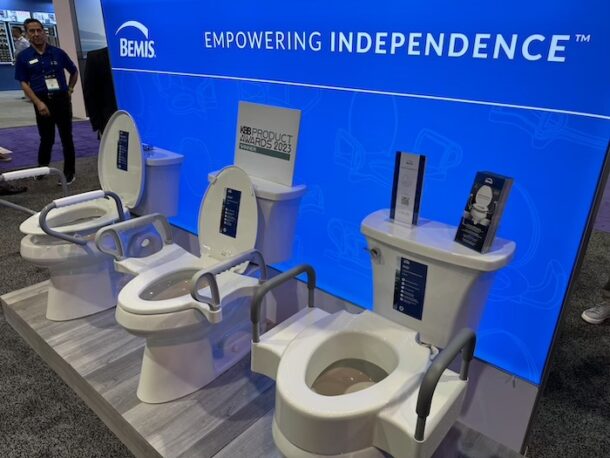
Everything from low-flow toilets, ADA & Living in Place to the latest in bidets, KBIS had it all. From the Bemis booth.
Invariably during every trade show I attend I get asked, “what was the most interesting thing you saw on the show floor?” Well, I gotta say it was the Genesis Systems WaterCube 100, which basically creates water out of the air. I was fairly shocked when I saw the size of this unit—large—to be installed on the exterior of the home. The company contends that the product sustainably generates more than 100 gallons of fresh water daily from the air around it—enough for a household of four, and it operates in humidity ranges of >40-100% and ideal climate temperatures of >59 degrees F.

Genesis Systems WaterCube 100
In the North Hall, we saw everything from the latest in bidets, low-flow toilets, high-end kitchen and bathroom fixtures to fancy multi-colored bathtubs—a kitchen and bath designer’s fantasy space, if you will.

Moen’s 3-in-1 Water Filtration Pulldown faucets dispense filtered cold water and hot and cold tap water, including a three-function pultdown wand. 3-in-1 Water Filtration Kitchen Pulldowns pair with any Moen filtration system and are available in many styles and finish options.
“2024 marks the 60-year anniversary of KBIS—a tremendous accomplishment and an opportunity to not only celebrate our growth but to set goals for how we want to continue to elevate the show and help drive the industry forward,” said Bill Darcy, Global President & CEO of NKBA|KBIS. “We’ve had great success collaborating with NAHB and IBS and are proud to announce our continued partnership as part of this milestone year. As the kitchen, bath, and wider residential building, architect, design, and remodeling sectors continue to grow it’s more important than ever to provide a central source for inspiration and innovation.”
NAHB and NKBA announced an agreement to extend the co-location of IBS and KBIS for four years through 2030.
Next year, DCW will return to Las Vegas, Feb. 25-27.

See you next year in Vegas!

Falls Church, Va. — For plumbing and HVACR contractors who are eager to make a difference, the Plumbing-Heating-Cooling Contractors—National Association (PHCC) is providing a timely opportunity to for them to do so by educating lawmakers during the May 21-22 PHCC Legislative Conference in Washington, D.C. As part of the conference, PHCC will facilitate visits between PHCC Read more
Falls Church, Va. — For plumbing and HVACR contractors who are eager to make a difference, the Plumbing-Heating-Cooling Contractors—National Association (PHCC) is providing a timely opportunity to for them to do so by educating lawmakers during the May 21-22 PHCC Legislative Conference in Washington, D.C.
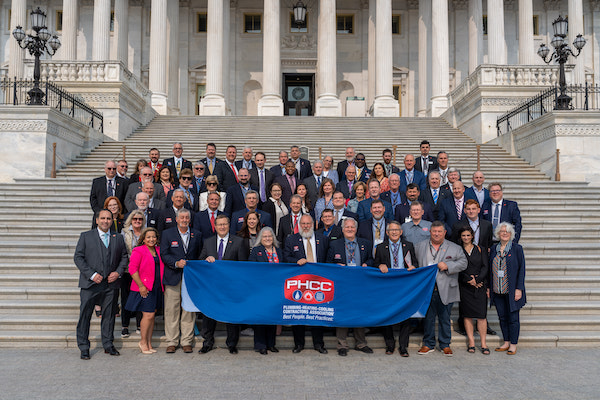
As part of the conference, PHCC will facilitate visits between PHCC members and the offices of their elected representatives. The policy priorities for this year are:
- Protecting America’s energy future through fuel choice,
- Educating lawmakers on the costs and realities of building electrification,
- And supporting workforce programs and registered apprenticeships.
First-time attendees shouldn’t be nervous, as the event will provide personalized coaching by PHCC’s federal lobbyists, an easy-to-use app to help you navigate your Capitol Hill visits, and much more.
In addition to hearing from PHCC’s and other industry experts, attendees will hear from this year’s keynote speakers:
- Rep. Martin Frost (D-TX)
- And Rep. Tom Davis (R-VA).
These speakers will provide an objective overview of the state of politics during this pivotal election cycle. A complimentary copy of their book, The Partisan Divide, will be given to all conference attendees.
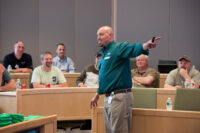
Training in 2024 is just as important as ever. How do you integrate training, education and continued learning with today’s busy contractor? Power Points, sales pitches and doughnuts. Tried and true methods of training gone by, that’s for sure. But what does today’s training look like, especially in the purview of the younger generation of Read more
Training in 2024 is just as important as ever. How do you integrate training, education and continued learning with today’s busy contractor?
Power Points, sales pitches and doughnuts. Tried and true methods of training gone by, that’s for sure. But what does today’s training look like, especially in the purview of the younger generation of contractors that digests information in 90 seconds or less?
“What was that? Sorry, I was looking at my phone,” jokes Max Rohr, Director, Education and Technical Marketing, Caleffi. “Five years ago, a three-minute-long video was a good option, now it will seem long if it is over that 90-second threshold. Ideally, you get to the point in the first five seconds and work the explanation back from there. Like showing the cake and then going back to bowls of ingredients.”
According to, Dave Holdorf, Residential Trainer & Rep Training Manager—Eastern Region, Taco Comfort Solutions, it’s a challenge. “We’ve found that it helps to bring different instructors in for specific segments of the training. Each instructor brings their own perspective; even hearing a different voice in the room makes for a more compelling presentation. Every facet of our training is now geared to maintain the attention of participants. We also make sure to schedule breaks so that the attendees can attend to business, or need at home. By creating the curriculum with attendees in mind, their focus remains with the topic in front of them.”
Nevertheless, the training department at Taco has always looked at training not from a product view but from an application perspective, giving attendees the information they need to do their job better, and to give their customers the comfort they deserve. “We use real world experiences to solve real world problems with personal experiences and a bit of humor—as you know, John, it ain’t worth doing if you’re not having fun as well,” says Holdorf.

Caleffi’s Bob “Hot Rod” Rohr brings his props and his wealth of experience and knowledge to trainings.
But what about those PowerPoints and doughnuts? “Every learning style is different, so you have to be adaptable. If you see the audience tuning out a PowerPoint, stop and grab a product to bring to an attendee and talk about a case study that is related instead,” says Rohr.
In addition, everything falls apart for a trainer if the audience gets the impression they are overpromising, adds Rohr. For example, “Honesty is something Hot Rod is specifically good at in contractor training sessions. As a former installer, he always has tips for getting the job done and workarounds that are really tangible,” says Rohr.
The New Normal?
The Covid pandemic saw what we thought was going to be a new normal with virtual training, but what we are now seeing is the importance, and return, of in-person training.
This past year Taco saw a huge jump of in-person training, on the road as well as at Taco HQ in Rhode Island. So much so that the company had to dramatically increase the number of sessions back in Rhode Island to accommodate. “However, that does not mean to diminish the virtual training, Taco Tuesday and Taco After Dark webinars are still posting a large number of attendees that are hungry for information in bite size chunks, not as large as when we all locked down at home, but still popular,” says Holdorf.
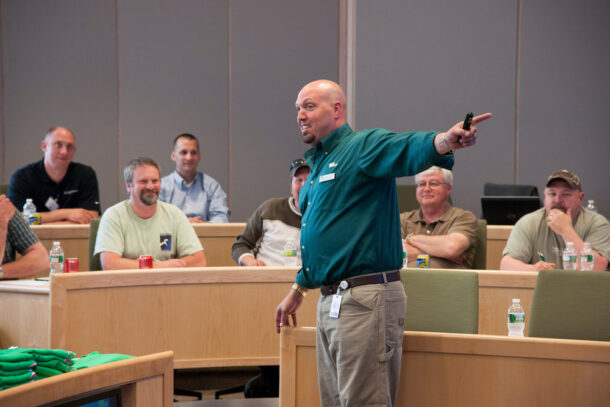
Taco’s Holdorf conducts a training at the Cranston, R.I. HQ.
Nonetheless, “when we’re online, we know it’s so easy to stray off to the next shiny thing online, so to keep attendees engaged, we encourage two-way communications. If participants have questions, we want them to ask immediately,” continues Holdorf.
In fact, Holdorf says that people who attend Taco’s webinars typically take it to the next level and seek live training. A combination of both virtual and live training can help attendees dial in on what they want to learn—or perhaps didn’t initially develop a full understanding of what it is they most needed to know. “These options allow them to fine-tune their training experience to make them as good as they want to be. And, ideally, we help them raise the bar. We routinely heard from trade pros who came to us for a better understanding of a single application or concept, and through that experience come away with an energized desire for much more,” says Holdorf.
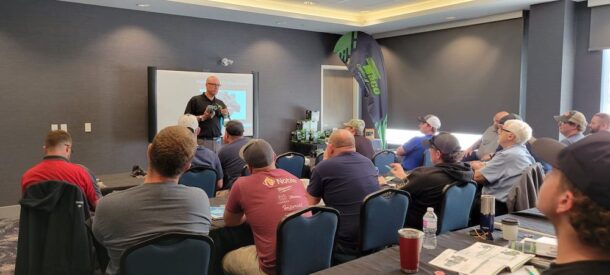
In 2023, Caleffi performed almost a 50/50 mix of in-person and virtual. Contractors like hands-on training, says Rohr, so it is good to be back on job sites for that type of interaction. And, engineers didn’t all go back to the office after COVID. “Many of the engineering sessions we do are virtual because that firm may be scattered all over the region. You might catch 20 people in a virtual training, where only 10 of them are in the office that day,” says Rohr.
Know-It-Alls
What about those who are stubborn enough to think that they don’t need further education and training? “I love this question and see and hear it often in the industry,” says Ken Midgett, L.M.P, Plumbing, Marketing Director, Interplay Learning, and former Teacher and Apprenticeship Instructor, Lehigh Career & Technical Institute.
Those in skilled trades should embrace the concept of being “lifelong learners,” consistently expanding their knowledge in their current specialty and exploring related disciplines. Whether licensed or not, individuals in skilled trades should assess their goals, career paths and professional growth within their field. It’s common for some to reach a point where they feel adequately skilled and think further education is unnecessary. According to Midgett, this assumption is misleading for several reasons:
• For example, a residential plumber could benefit from learning about commercial plumbing, Med Gas, Backflow, Water Well work, Water Conditioning, HVAC, Electrical, etc. Diversifying skills not only enhances one’s expertise but also increases their marketability across various skill sets, intern boosting income and long-term employability.
• Despite advancements in safety measures within the construction industry, the misconception that skilled trades workers are immune to injuries persists. While the overall safety landscape has improved, life-changing injuries can still occur. In such unfortunate instances, if an individual can only rely on skills specific to their trade and lacks versatility, their career may face irreparable damage. Therefore, investing in ongoing training, education, and professional development becomes crucial for ensuring resilience in the workforce and mitigating the impact of unforeseen challenges. Repurposing skillsets may be challenging when there has been no prior skill or professional development planning before the injury event.
• The industry, codes, tools, and methods to do a task are constantly changing. Skilled trades workers need to educate themselves and stay on top of new developments. This is critical to the success of a technician and company.
In the end, it’s what ends up in the ol’ noggin as useful information that translates to the jobsite. “Students only retain a tiny amount of the information that you present to them, but they will remember their feelings about the trainer for a very long time,” says Rohr. “It is hard to know if a bigger win is when customers retain a piece of information you presented or if they remember that you seem like you know what you are talking about. “If they trust that you did a good job, that memory will stay with them for a career, potentially.”
